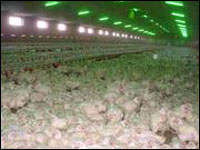Chicken run ! – on the environmental impact of broiler production systems

Intensive indoor broiler production <br>Photograph: Martina Wolf-Reuter
A broiler chicken produces an average 115g excrements a day; this amounts to 2 million tons a year in Germany alone. In terms of plant nutrients this is equivalent to 33 million kg nitrogen (N) and 7 million kg phosphorus (P). The environmetal effects of these nutrients and their interaction with different production systems has been investigated by scientists of the Institute of Plant Nutrition and Soil Science of the Federal Agricultural Research Centre (FAL) in Braunschweig, Germany.
A nationwide study compared intensive indoor, free range and organic broiler production systems. In the intensive indoor system with 22-24 animals per square metre, i.e. altogether 20,000-40,000 animals in one building (picture 1), the birds achieve their final weight of 1.8 kg after roughly 6 weeks and during that time they have produced “only” about 5 kg excrements per broiler. However these accumulated high amounts of excrements cannot be disposed of easily and only by following the approved codes of “good agrcultural practice”, which states the amount per acre according to be applied according to the approved N and P needs of plants.
The free range chicken, shares a square meter with 13 others, in flocks of about 6,000-15,000 birds and an average stocking rate of about 1 m2 per bird in the free range. This makes their life not only more varied but also a bit longer. In spite of the same final fattening weight of 1.8 kg, their life is extended by two weeks, which therefore leaves more droppings. An additional problem: During the study the birds mostly stayed near their building, so hardly more than 30 % of the actual exercise area was used with the consequence, that it received a far higher enrichment with N and P, to the extent that it was a potential pollution risk to the ground- and surface waters.
By comparison, an organic broiler enjoys comparative luxury in its free range mobile house. These movable huts typically have 300 birds with access to 30 m2 each and a minimum free range of 600 m2 (picture 2). The EU regulation on organic farming (EU 2092/91) guarantees an organic broiler a life span of at least 12 weeks, which in practice is closer to 22 weeks. But with a higher final weight of 2.8 kg there is an ecological price to pay: on average the excrement from an organically raised broiler accumulates to 16 kg per bird. However, these are better distributed on the area resulting from the smaller, movable housing units which are rotated around the field to better match the soils’ storage capacity and the plants’ needs.
With the slogan “freedom tastes better” the German minister for consumer protection Mrs Kuenast (federal minister for consumer protection, nutrition and agriculture) advertises broiler farming methods which are in accordance to animal welfare. Even if not every palate may comprehend that, like for every freedom you have to pay, also for the roast chickens’ one. But isn’t it like the famous pilosopher Immanuel Kant wrote already 250 years ago “If he is not to stifle his human feelings, he must practice kindness towards animals, for he who is cruel to animals becomes hard also in his dealings with men”?
Contact: Prof. Dr. Dr. Ewald Schnug, Federal Agricultural Research Centre (FAL), Institute of Plant Nutrition and Soil Science, Bundesallee 50, D-38116 Braunschweig, Germany, fone +49 531 596 2101, fax +49 531 596 2199, E-mail: pb@fal.de
Media Contact
All latest news from the category: Agricultural and Forestry Science
Newest articles

High-energy-density aqueous battery based on halogen multi-electron transfer
Traditional non-aqueous lithium-ion batteries have a high energy density, but their safety is compromised due to the flammable organic electrolytes they utilize. Aqueous batteries use water as the solvent for…

First-ever combined heart pump and pig kidney transplant
…gives new hope to patient with terminal illness. Surgeons at NYU Langone Health performed the first-ever combined mechanical heart pump and gene-edited pig kidney transplant surgery in a 54-year-old woman…

Biophysics: Testing how well biomarkers work
LMU researchers have developed a method to determine how reliably target proteins can be labeled using super-resolution fluorescence microscopy. Modern microscopy techniques make it possible to examine the inner workings…





















